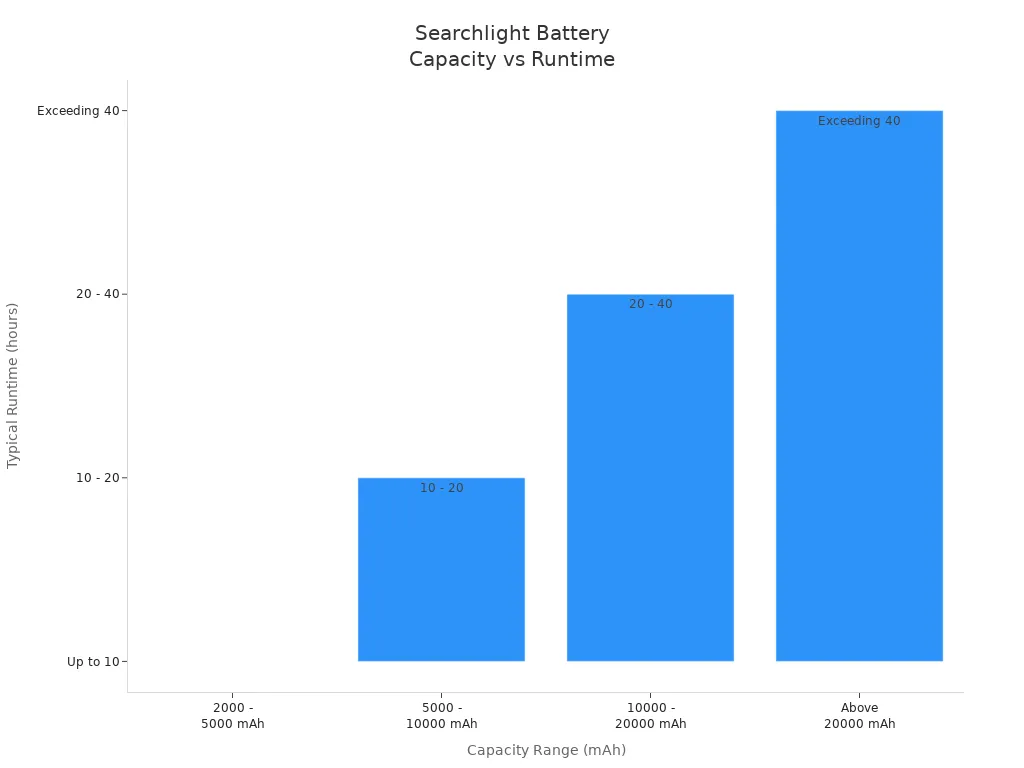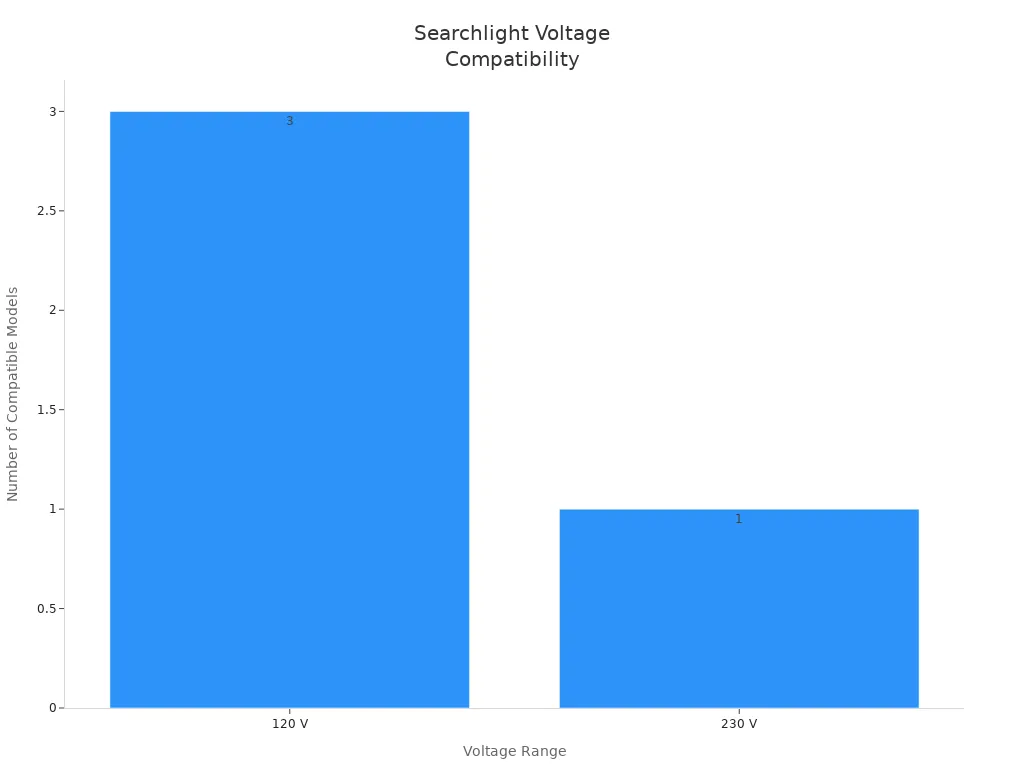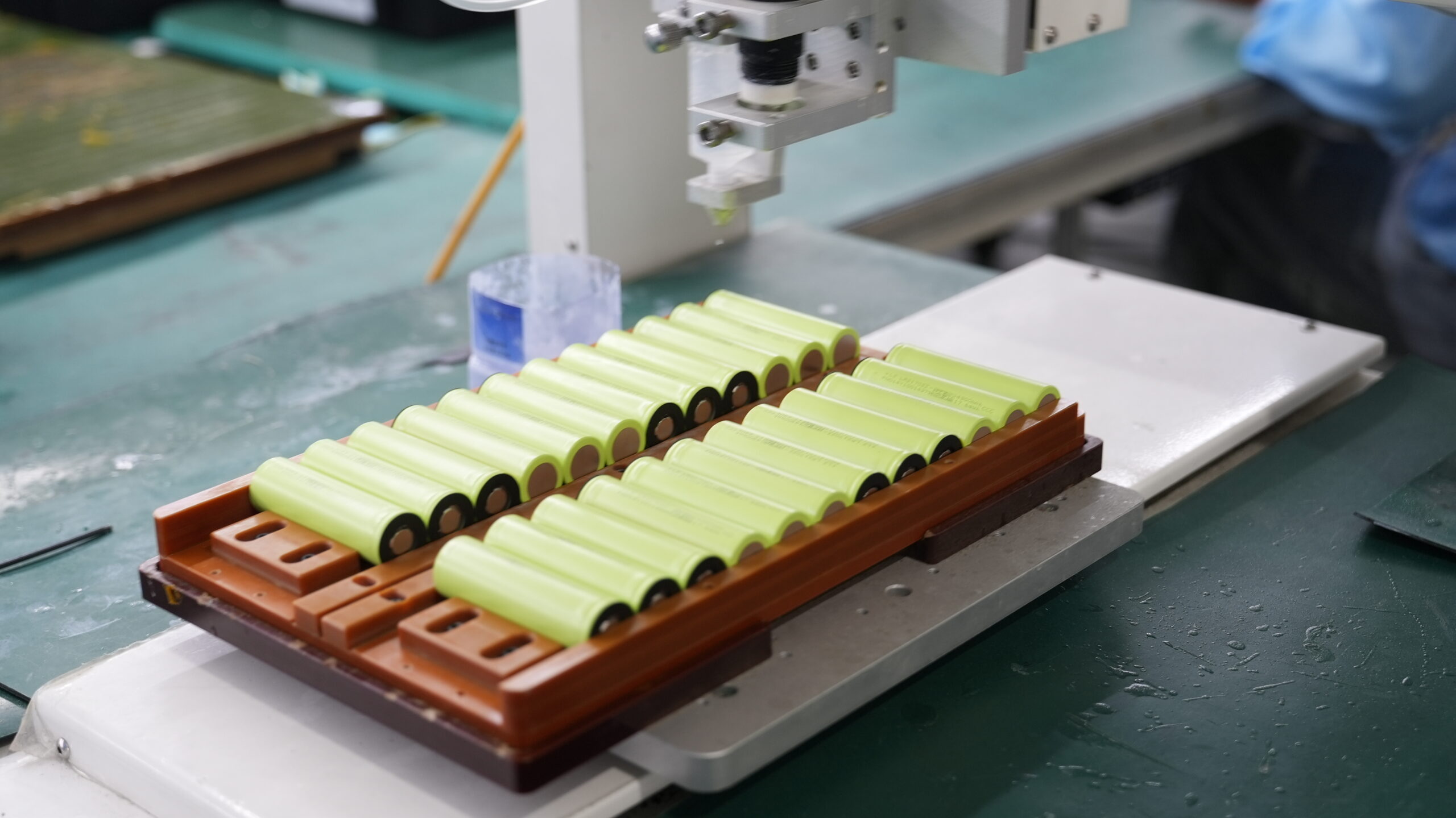
Selecting the best battery for your searchlight determines reliability and operational safety. Industry data shows 65% of failures stem from battery issues:
Type of Battery Issue | Percentage |
|---|---|
Linked to operation and integration | 65% |
Caused by failures of battery cells/modules | 11% |
LiFePO4 lithium battery for searchlight offers a safety guarantee, ideal battery type, and meets battery requirements for flashlight battery selection. You choose batteries that deliver consistent brightness and long cycle life.
LiFePO4 technology supports the best lithium battery performance.
Enhanced safety and eco-friendliness set the standard for the best battery in demanding environments.
Key Takeaways
Choose LiFePO4 batteries for superior safety and long cycle life, ensuring reliable performance in demanding environments.
Match the battery capacity to your expected runtime; higher capacity batteries provide longer operation and maintain brightness.
Always verify voltage compatibility with your searchlight to prevent overheating and performance issues.
Part 1:Battery Criteria for Searchlights

1.1 Lithium Battery Types
You must understand the available battery types before selecting a lithium battery for searchlight applications. The three most common chemistries are lithium-ion, lithium-polymer, and LiFePO4 battery. Each offers unique advantages and trade-offs for searchlight performance.
Type of Battery | Advantages | Disadvantages |
|---|---|---|
Lithium-Ion Batteries (Li-ion) | Most common, high energy density, lightweight. | Higher cost, finite charging cycles. |
Lithium-Polymer Batteries (Li-Po) | Thin, lightweight, non-flammable, ideal for portable devices. | Limited cycle life compared to Li-ion. |
Lithium-Iron-Phosphate (LiFePO4) | Greater thermal stability, safety, and longevity. | Lower energy density than Li-ion. |
LiFePO4 battery stands out for its superior safety, long cycle life, and thermal stability. You benefit from a lithium battery for searchlight that resists overheating and internal short circuits. Lithium-ion batteries deliver high energy density and lightweight construction, making them suitable for portable searchlights. Lithium-polymer batteries offer flexibility in shape and size, which is ideal for compact designs.
Tip: Always verify the chemistry of your lithium battery for searchlight to ensure it matches your operational requirements and safety standards.
When you evaluate battery types, consider the following:
High energy density and lightweight design improve portability.
Stable voltage throughout discharge ensures consistent brightness.
Long cycle life (2,000–6,000 cycles) reduces replacement frequency.
Advanced monitoring features in rechargeable batteries enhance safety.
However, you should also weigh disadvantages:
Higher upfront cost for advanced chemistries like LiFePO4 battery.
Temperature sensitivity can affect performance.
Recycling limitations may impact sustainability goals.
1.2 Capacity and Runtime
Battery capacity directly determines how long your searchlight operates at optimal brightness. You need to match the battery capacity (measured in mAh) to your expected runtime and application scenario. The following table summarizes typical capacity ranges and their corresponding runtimes:
Capacity Range (mAh) | Typical Runtime (hours) | Usage Scenario |
|---|---|---|
2000 – 5000 | Up to 10 | Personal use, short-term emergency lighting |
5000 – 10000 | 10 – 20 | General-purpose, regular use in various applications |
10000 – 20000 | 20 – 40 | Industrial-grade, extended use for large-scale operations |
Above 20000 | Exceeding 40 | Specialized, heavy-duty applications requiring long-term lighting |

You should select a lithium battery for searchlight with a capacity that supports your operational needs. Higher capacity rechargeable batteries (3,000mAh and above) provide longer runtime and help maintain brightness, even in challenging conditions. The discharge rate also plays a crucial role. High brightness settings increase the discharge rate, which can reduce runtime. Efficient LEDs and a well-matched battery type help optimize both brightness and longevity.
Smaller batteries lead to shorter runtimes and frequent recharging.
Larger batteries extend operational duration, which is essential for field operations.
Runtime can vary between seasons due to temperature effects on internal resistance.
Note: Always consider the discharge rate and internal resistance when estimating runtime. High internal resistance can cause voltage drops, reducing both brightness and efficiency.
1.3 Voltage Compatibility
Voltage compatibility ensures your lithium battery operates safely with your searchlight’s electronics. Most commercial searchlights require specific voltage ranges to function correctly. The table below outlines common voltage requirements for different bulb types:
Voltage | Bulb Type | Wattage |
|---|---|---|
120 | Incandescent | 750 |
120 | Quartz/Halogen | 750 |
120 | Quartz/Halogen | 1000 |
230 | Quartz/Halogen | 1000 |

You must match the lithium battery voltage to your searchlight’s requirements. Incorrect voltage can cause overheating, reduced performance, or even permanent damage. LiFePO4 battery typically offers a nominal voltage of 3.2V per cell, which suits many industrial searchlight designs. Always check the manufacturer’s specifications for voltage and discharge rate compatibility.
Alert: Using a battery with the wrong voltage or excessive internal resistance can trigger protection circuits, leading to unexpected shutdowns or reduced output.
Additional Criteria for B2B Buyers
When you select a lithium battery for searchlight, you must also evaluate:
Protection features: Overcharge, over-discharge, short circuit, reverse polarity, and overheat regulation are essential for safe operation.
Internal resistance: Lower internal resistance improves efficiency and reduces heat generation.
Cycle life: LiFePO4 battery offers up to 6,000 cycles, minimizing replacement costs.
Size and weight: Lightweight rechargeable batteries enhance portability and ease of installation.
Warranty: Top manufacturers offer 1–3 year warranties, reflecting confidence in product reliability.
Brand reputation: Brands like Panasonic, Tesla, Samsung, Sony, LG, and Duracell consistently receive high reliability and customer satisfaction ratings.
Safety certifications: Look for UN38.3, UL1642, IEC62133, CE, RoHS, and UKCA certifications to ensure compliance with international standards.
By considering these criteria, you ensure your lithium battery for searchlight delivers optimal performance, safety, and long-term value in demanding environments.
Part 2:Choose the Right Lithium Battery for Searchlight

2.1 Match Battery Specs
Selecting the optimal lithium battery for searchlight applications requires a systematic approach. You must align battery specifications with your searchlight’s technical requirements to ensure peak performance and safety. Follow these steps to choose the right lithium battery:
Check the Device’s Manual
Review the searchlight’s technical documentation. Manufacturers specify recommended battery chemistries (LiFePO4, NMC, LCO, LMO, LTO), size, and capacity. This information forms the foundation for your selection.Assess Power Consumption and Desired Runtime
Calculate the searchlight’s power draw and determine how long you need it to operate. Select a lithium battery with sufficient capacity (mAh or Wh) to meet your operational goals.Verify Voltage Requirements
Ensure the battery’s platform voltage matches the searchlight’s operating voltage. Mismatched voltage can cause malfunction or damage.Evaluate Size and Weight Constraints
Confirm the battery fits within the device’s physical space and weight limits. Compact lithium battery packs enhance portability and ease of installation.Compare Battery Chemistries
Analyze the pros and cons of available chemistries. For example, LiFePO4 offers high cycle life (up to 6,000 cycles), stable platform voltage (3.2V per cell), and robust safety features. NMC and LCO provide higher energy density but may have shorter lifespans.
Tip: Always consult with your supplier or manufacturer for custom battery solutions tailored to your searchlight fleet.
Specification | Value |
|---|---|
Battery operating voltage | 21.6 V |
Ambient temperature for operation | −17 ℃ … 60 ℃ |
Storage temperature | −20 ℃ … 40 ℃ |
Battery charging starting temperature | −10 ℃ … 45 ℃ |
You should comply with safety instructions for handling lithium batteries. Use only batteries in perfect working order and avoid exposing them to moisture, heat, or direct sunlight.
2.2 Check Compatibility
Compatibility checks are essential to prevent operational failures and warranty issues. You must verify that the lithium battery for searchlight matches all technical and safety requirements.
Compatibility Check | Details |
|---|---|
Battery Type | Use only manufacturer-recommended LiFePO4 batteries to avoid damage and warranty voiding. |
Charger Compatibility | Purchase a LiFePO4-compatible charger and cord. Older chargers may not work with new chemistries. |
Discharge Current and C-Rating | Ensure the battery’s discharge current meets or exceeds the searchlight’s requirements. |
Performance Risks | Inadequate discharge current can reduce performance or cause malfunction. |
You must confirm the battery’s discharge current and C-rating align with your searchlight’s specifications. Using an incompatible charger or battery type can lead to reduced performance or permanent damage. Always source lithium batteries from reputable suppliers who provide technical support and documentation.
Alert: Never mix battery chemistries or use non-approved chargers. This practice can void warranties and compromise safety.
2.3 Optimize Performance
Maximizing the performance and lifespan of your lithium battery for searchlight involves proactive maintenance and operational best practices. You can implement the following expert tips:
Avoid Over-Discharge
Use batteries with built-in protection circuits. Prevent draining the battery to 0%, which can shorten its lifespan.Winter Storage
Remove batteries from searchlights in cold climates. Store them at room temperature and recharge every 2–3 months.Upgrade to LiFePO4
Consider lithium iron phosphate batteries for superior cycle life and temperature resilience.Opt for Smart Solar Lights
Choose searchlights with sensors that optimize charging and discharging cycles.Regular Maintenance
Inspect and clean battery terminals and wiring every three months. Clean solar panels and light fixtures to remove dust and debris.
Regular maintenance and care are crucial for the longevity and performance of lithium batteries in searchlights.
Checking and replacing batteries ensures they continue to hold a charge effectively.
For B2B clients, procurement decisions impact cost and reliability. You should:
Assess certifications and compliance standards (UN38.3, UL, IEC62133, CE).
Evaluate production capacity and infrastructure for high-volume orders.
Review customer feedback and market reputation.
Inquire about customization options for battery packs.
Verify warranty and after-sales support.
Ensure clear and consistent communication with suppliers.
Bulk purchasing and strong supplier relationships can reduce costs and improve reliability. The U.S. imported $13.9 billion in lithium-ion batteries in 2022, with $9.3 billion from the PRC. Supply chain resilience is critical for large fleets and defense operations. You should consider domestic production and recycling strategies to mitigate risks.
Note: For tailored solutions and custom lithium battery packs, consult directly with your manufacturer or supplier.
You improve battery selection by following a clear process. Review technical requirements, confirm voltage and capacity, and check certifications. Use this checklist for battery selection:
Match chemistry and platform voltage
Verify cycle life and energy density
Audit manufacturer quality and responsiveness
Confirm compliance and financial stability
Consult technical specialists for tailored battery selection and long-term reliability.
FAQ
What makes Large Power’s lithium battery packs suitable for industrial searchlights?
Large Power designs lithium battery packs with high cycle life, robust safety features, and stable platform voltage. You can request a custom battery solution for your industrial needs.
How do you select the right battery chemistry for security or medical applications?
You should compare chemistries like LiFePO4, NMC, and LCO. Review platform voltage, energy density, and cycle life. See security or medical battery solutions for tailored options.
Can you customize lithium battery packs for robotics or infrastructure projects?
Yes. Large Power offers custom lithium battery packs for robotics and infrastructure projects. Click for custom consultation to match your technical requirements.




